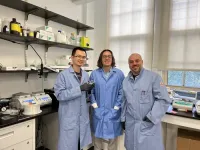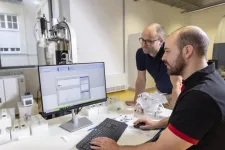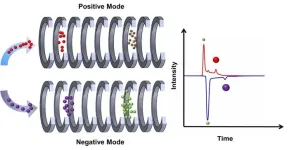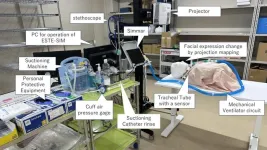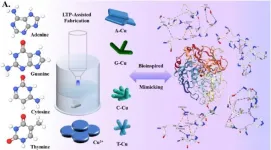(Press-News.org) Penn Engineers have cooked up a new way to improve mRNA delivery, developing an optimal “recipe” for ionizable lipids — key ingredients in lipid nanoparticles (LNPs), the molecules behind the COVID-19 vaccines and other innovative therapies. The method, described in Nature Biomedical Engineering, mirrors the iterative process of developing a culinary dish and may lead to safer, more effective mRNA vaccines and therapeutics.
Just as a chef perfects a dish by experimenting with flavors and textures, the researchers used an iterative process, testing variations to find the ideal structure for the ionizable lipid. This lipid’s structure influences the ability of LNPs to successfully deliver their contents and advances mRNA therapies for vaccines and gene editing.
A Breakthrough in LNP Design
Nanoparticles have transformed how mRNA vaccines and therapeutics are delivered by allowing them to travel safely through the body, reach target cells and release their contents efficiently. On its own, RNA is fragile, and would otherwise dissolve without ever reaching its intended target.
At the heart of these nanoparticles are ionizable lipids, special molecules that can switch between charged and neutral states depending on their surroundings. This switch is essential for the nanoparticle’s journey: In the bloodstream, ionizable lipids stay neutral, preventing toxicity. But once inside the target cell, they become positively charged, triggering the release of the mRNA payload.
Led by Michael J. Mitchell, Associate Professor in Bioengineering, the researchers refined this delivery process by optimizing the structure of ionizable lipids. Moving beyond existing methods limited by tradeoffs between speed and accuracy, the team developed a step-by-step, “directed chemical evolution” process. Through five cycles, with each further refining the lipids, they created dozens of high-performing, biodegradable lipids — some even surpassing industry standards.
The Secret Sauce: Directed Chemical Evolution
To develop safer, more effective ionizable lipids, the Penn Engineers employed a unique approach that combines two prevailing methods: medicinal chemistry, which involves slowly and laboriously designing molecules one step at a time, and combinatorial chemistry, which involves generating many different molecules quickly through simple reactions. The former has high accuracy but low speed, while the latter has low accuracy and high speed.
“We thought it might be possible to achieve the best of both worlds,” says Xuexiang Han, the paper’s first author and, until recently, a postdoctoral fellow in the Mitchell Lab. “High speed and high accuracy, but we had to think outside the traditional confines of the field.”
By borrowing the idea of directed evolution, a technique used in both chemistry and biology that mimics the process of natural selection, the researchers combined precision with rapid output to achieve their ideal lipid “recipe.”
The process begins with the generation of a wide variety of molecules, which are screened for their ability to deliver mRNA. The best-performing lipids are then used as starting points for generating another round of molecular variants, and so on, until only high-performing variants remain.
An Innovative Ingredient: A3 Coupling
A crucial contributor to the team’s recipe for improved ionizable lipids is A3 coupling, a three-component reaction named for its chemical ingredients: an amine, an aldehyde and an alkyne.
The reaction, which has never been leveraged to synthesize ionizable lipids for LNPs, uses inexpensive, commercially available ingredients and produces only water as a byproduct, making it a cost-effective and environmentally friendly choice for rapidly producing the large numbers of ionizable lipid variants needed as ingredients for directed evolution.
“We found that the A3 reaction was not only efficient, but also flexible enough to allow for precise control over the lipids’ molecular structure,” says Mitchell. This flexibility was key to fine-tuning the ionizable lipid properties for safe and effective mRNA delivery.
Why This Advance Matters
This new method for designing ionizable lipids is expected to have broad implications for mRNA-based vaccines and therapeutics, which are poised to treat a range of conditions, from genetic disorders to infectious diseases.
In this work, the optimized lipids improved mRNA delivery in preclinical models for two high-priority applications: editing genes that cause hereditary amyloidosis, a rare disease that results in abnormal protein deposits throughout the body, and improving delivery of the COVID-19 mRNA vaccine. In both cases, the engineered lipids showed higher performance than current industry-standard lipids.
Beyond these specific applications, the new approach has the potential to accelerate the development of mRNA therapies overall. While it can take years to develop an effective lipid using traditional methods, the team’s directed evolution process could reduce this timeline to just months or even weeks.
“Our hope is that this method will accelerate the pipeline for mRNA therapeutics and vaccines, bringing new treatments to patients faster than ever before,” says Mitchell.
A New Frontier for mRNA Delivery
LNPs represent a safe, flexible way to deliver genetic material, but their success hinges on the properties of their ionizable lipids. The Penn Engineers’ iterative design process allows researchers to improve these lipids with unprecedented speed and precision, bringing the next generation of mRNA therapies closer to reality.
With this innovative recipe for LNPs, Penn Engineers have taken a major step forward in advancing mRNA technology, offering hope for a faster and more efficient path to life-changing treatments.
This study was conducted at the University of Pennsylvania School of Engineering and Applied Science and supported by a U.S. National Institutes of Health (NIH) Director’s New Innovator Award (DP2 TR002776), a Burroughs Wellcome Fund Career Award at the Scientific Interface (CASI), a US National Science Foundation CAREER Award (CBET-2145491), an American Cancer Society Research Scholar Grant (RSG-22-122-01-ET) and iECURE.
Additional co-authors include Kelsey L. Swingle, Junchao Xu, Ningqiang Gong, Lulu Xue, Giangqiang Shi and Il-Chul Yoon of Penn Engineering; Rohan Palanki, of Penn Medicine and Penn Engineering; Mohamad-Gabriel Alameh, Rakan El-Mayta, Garima Dwivedi, James M. Wilson and Drew Weissman of Penn Medicine; and Claude C. Warzecha of Gemma Therapeutics.
END
Cooking up a breakthrough: Penn engineers refine lipid nanoparticles for better mRNA therapies
2024-11-22
ELSE PRESS RELEASES FROM THIS DATE:
CD Laboratory at Graz University of Technology researches new semiconductor materials
2024-11-22
The global production of semiconductors is growing rapidly and with it the demand for primary products, especially crystalline silicon. However, its production is very energy-intensive and only half of the raw silicon used is actually utilised. This leads to large quantities of waste. In the Christian Doppler Laboratory for New Semiconductor Materials Based on Functionalized Hydrosilanes, which opened today, a team led by laboratory manager Michael Haas from the Institute of Inorganic Chemistry at Graz University of Technology (TU Graz) is carrying out research on alternatives. Funded by the Austrian Ministry of Economics and Labour, the researchers are working with ...
Animal characters can boost young children’s psychological development, study suggests
2024-11-22
Children’s books are full of animal characters whose antics capture the hearts and inspire the imaginations of their young readers.
However, a new study has shown that iconic characters such as Peter Rabbit – or Toad and Ratty from The Wind in the Willows – can also play an important role in children’s psychological development.
The research explored the extent to which different non-human characters influence children’s theory of mind skills, which include the ability to read and predict social changes in the environment through tone of voice, choice of words, or facial expression.
For ...
South Korea completes delivery of ITER vacuum vessel sectors
2024-11-22
The ITER vacuum vessel sectors, manufactured in South Korea, have been successfully delivered to the ITER construction site in Cadarache, France. South Korea was responsible for manufacturing 4 out of the 9 sectors that make up the ITER vacuum vessel. Starting with the delivery of the first sector in 2020, South Korea has now completed all four sectors, fulfilling its commitment to this significant international project.
The ITER vacuum vessel is a key component that sustains the ultra-high-temperature plasma required for nuclear fusion reactions by maintaining a high-vacuum environment. This large structure weighs 5,000 tons and consists of 9 sectors and ...
Global research team develops advanced H5N1 detection kit to tackle avian flu
2024-11-22
Singapore – The Diagnostics Development Hub (DxD Hub), a national platform hosted by the Agency for Science, Technology and Research (A*STAR), Singapore, in collaboration with the National Institute for Environmental Studies (NIES), Japan, and the A*STAR Bioinformatics Institute (A*STAR BII), has successfully developed Steadfast, an advanced diagnostic kit for detecting the highly pathogenic H5N1 Avian Influenza Virus (AIV). This development marks a significant breakthrough in avian influenza monitoring, reinforcing global efforts in pandemic preparedness.
Steadfast ...
From food crops to cancer clinics: Lessons in extermination resistance
2024-11-22
Just as crop-devouring insects evolve to resist pesticides, cancer cells can increase their lethality by developing resistance to treatment. In fact, most deaths from cancer are caused by the evolution of therapeutic resistance.
In a new review, Arizona State University researchers, working with colleagues around the world, explore how established agricultural pest management strategies could be adapted to address cancer therapy. The pioneering method opens new possibilities for controlling drug resistance and improving patient survival.
The research, which appears in the current issue of the journal Cancer Research, explores 10 pest management principles that could ...
Scientists develop novel high-fidelity quantum computing gate
2024-11-22
Researchers from the RIKEN Center for Quantum Computing and Toshiba have succeeded in building a quantum computer gate based on a double-transmon coupler (DTC), which had been proposed theoretically as a device that could significantly enhance the fidelity of quantum gates. Using this, they achieved a fidelity of 99.92 percent for a two-qubit device known as a CZ gate and 99.98 percent for a single-qubit gate. This breakthrough, which was carried out as part of the Q-LEAP project, not only boosts the performance ...
Novel detection technology alerts health risks from TNT metabolites
2024-11-22
Recently, a research group led by Prof. HUANG Chaoqun from the Hefei lnstitutes of Physical Science of the Chinese Academy of Sciences, developed an innovative dual drift tube ion mobility spectrometry (DDT-IMS) technology. This novel approach has successfully facilitated the rapid detection of both positive and negative ions of four toxic metabolites derived from 2,4,6-Trinitrotoluene (TNT), allowing for the detection of residual metabolites in the human body and providing valuable health warnings.
The research results were published in Talanta.
TNT undergoes biodegradation under the influence of fungi and bacteria, producing hazardous metabolites ...
New XR simulator improves pediatric nursing education
2024-11-22
A new simulator gives nursing students hands-on practice with vital procedures like mechanical ventilation and tracheal suctioning in children.
Researchers at Hokkaido University in Japan have created a new training tool to equip nursing students with the skills needed in caring for children who require mechanical ventilation and tracheal suctioning. In a study published in the Journal of Nursing Care & Reports, the team highlighted the simulator's role in addressing the significant increase ...
New copper metal-organic framework nanozymes enable intelligent food detection
2024-11-22
Recently, a team led by Prof. HUANG Qing from the Hefei Institutes of Physical Science of the Chinese Academy of Sciences, successfully used the gas-liquid interface dielectric barrier (DBD) low-temperature plasma (LTP) technology to prepare a series of Cu metal organic framework (MOF) nanozymes.
“These nanozymes have different base ligands and mimic the activity of laccase,” said Prof. HUANG. The team also developed encoded array sensors for intelligent sensing and identification of bioactive components in food.
The relevant research ...
The Lancet: Deeply entrenched racial and geographic health disparities in the USA have increased over the last two decades—as life expectancy gap widens to 20 years
2024-11-22
The differences in US health and life expectancy based on where an individual lives, the economic conditions in that location, and their racial and ethnic identity have increased over the last two decades, leading to substantial health disparities that divide the USA into ten mutually exclusive populations, which the study authors term “The ten Americas”.
The life expectancy gap—an important indicator of a population’s health— across these ten Americas increased from 12·6 years in 2000 to 20·4 years in 2021, exacerbated by the COVID-19 pandemic.
Between 2000 and 2010 life expectancy increased in nine out of ten Americas, but between 2010 ...
